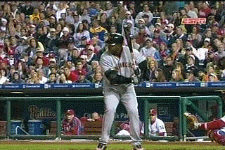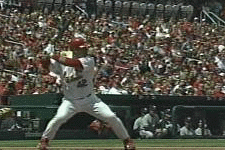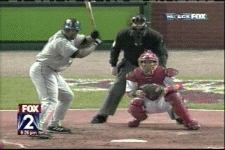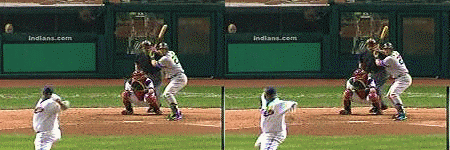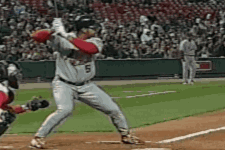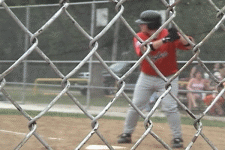Evidence?
Dmac or bbscout for those not in the know was a MLB scout. He posted on several sites under different names and on this site, he was greatly appreciated and was a valuable member. His passing shocked us all and you can find a thread under a search for bbscout to read up on him impact upon others and contributions on this site.
Richard wants to use “go” as the point of frame counts to determine efficiency in the swing and I opt to lean toward what this MLB Scout used. He said, regarding counting frames:
“I basically do it the same way as Steve, except I tie in the footplant and first bathead movement together. Most of the time the bathead will start moving when the foot is planted solidly, but not always. If the hitter picks up the change or something other than a fastball he will usually have a slight delay (about 1 frame) before the bat starts to move. In that case, I will go on the first bathead movement. For the most part, I go on first bathead movement, but the good hitters have it going at the same time the foot is firmly planted, so you will get the same count either way if the hitter is sitting fastball and gets a fastball. Those are in his words unedited. To be sure, frame count IS ONLY ONE CRITERIA FOR DETERMINING AN EFFICIENT SWING. You still have to have the ability to hit the ball. In making this point, Encinides, on another site, reminded everyone that bbscout (dmac) made a comment with regards to hitting and frame count that “Vlad” had a 5 frame swing and that his son had had a 4 frame swing but it “sucked.” He then mentioned that he had worked with his son and now it was around a 5 frame swing. Thus, and again, making the point that frame count is simply one tool. The necessity then is to have a “tool” or “measurement” that is approximate to a standard. As I have stated before, I can tell when the heel plants or the bat tip moves. I’m less comfortable when I think I can tell that a hitter is beyond the point of no return. I’m sure many of us have seen MLB hitters get far into the swing process and check a swing to the point that they have cause injury or damaged equipment. I would suggest that they were beyond that mythical “go.”
Evidence?
You posted this video of your son:

There is a tremendous amount of EVIDENCE not included in these videos – pitch speed, pitch location, etc. One simple explanation, although there could be many, for the open hips on the right is that the pitch was inside. In the pitch on the left, the pitch appears to be middle outside. Important EVIDENCE when discussing and comparing two swings.
With regards to EVIDENCE, one of the people that frequents your site made the comment that when using Dmac’s system that it isn’t unusual for many MLB hitters to have 5.5 or greater frame counts. He referenced his opinion that some have 7.5 using that method. He then posted video EVIDENCE to support his conclusion. However, when others downloaded that EVIDENCE (video) and the posted it in a larger version, it became apparent that on the screen one could see the speed of the pitch. It was 80 mph. Dmac’s process, which he clearly defined, required fastballs. Was this a simple error by that poster or was this voodoo video EVIDENCE.
“EVIDENCE” would be suspect as proof since posters can easily reference the countless videos posted by you in support of another philosophy, doggedly attacked others, and submitted that anyone who didn’t see the EVIDENCE right in front of them and demonstrated in the video was … You were as Emphatically right then as you profess to be now. Says a lot about “EVIDENCE.”
Separation:
The concept of “separation” exist, in large part, due to semantics and not physical practice. I would agree that perhaps a part of the argument might be in duration. People who then don’t agree with the phrase “separation” make distinctions based upon kinetic links which can’t be seperated. I can’t think of any person that swings a bat that doesn’t create separation in terms of basic kinematics (The study of how an object, in this case, hitter, change with time.) in measurements of segment differentials of movement while attempting acceleration or deceleration. In short, no one that I know who promotes a sense of rotational hitting would assert, as you suggest, that you draw a straight line referencing the back shoulder and hip and then say that they will remain in that relationship for the entire swing process. The “Rotational Mechanics” of the body state that there is a relationship between the hips and the shoulder (or any torso part) due to the bone and muscle structure. In other words, your muscles are NOT like rubber bands. They attach via tendons to bones and so, that muscle/bone relationship has a measurement that can not be extended without injury. (Please pardon me if some of this is wordy. I’m using my old anatomy notes and they are at best hard to read.) I believe that P-a-u-l N. stated from his research that, “From a real-world perspective is virtually impossible to "practice" effective separation. Because high-level players exhibit no more than 1 to 1/2 frames (30 frames per second or less than.05 seconds) of separation between hips opening (initiating rotation) and shoulders following (rotating).” That was using Dmac’s frame count. I believe he went further on to say that swinging a bat is a ballistic activity wherein if you think about it, you inhibit the process. Adair’s rock on a rope analogy” is essentially this demonstrated in practice.
Dan Lorenz, in a recent article mentioned that there is a finite and definite relationship between the hips and shoulders. Dan Lorenz, MS, PT, ATC/L, CSCS who works with the Kansas City Chiefs describes the Serape Effect as, “The connection from the hip to the shoulder is analogous to the muscles of the trunk and their ability to help rotation occur within the trunk. These muscles are the rhomboids, serratus anterior, and the external/internal obliques.” Collectively, contraction of these muscles enable us to remain upright, and yes, function in the swing process.
Doctor T. Inohiza (Sp) in 2003 wrote an article about the muscles and skeleton and baseball. In that article he suggested that if you thought of the relationship of the pelvic region and the shoulders via the torso during the swing process, it was comparable to making a cast while fishing. The base of the rod will move first but then, the tip will soon follow. Because of the nature of the rod, the tips response is almost instantaneous. Ask yourself if that isn’t what you see with these videos of MLB hitters. How many people reading this thread fired their hips while cognitively telling their shoulders to wait? Then, told them to “go.” (BTW, Dr. Inohiza suggest that there isn’t as much of a “stretch” of the muscles as there is a “twist” of the muscles.)
Image of Serape effect:

The brain can not tell an individual muscle group to function. All relations are based upon contractions. One of the best analogies of the core muscles is that they are like a transmission of a car, they can slow the process down some but you don’t want to use them as a brake.
I would suggest that all give this post serious thought when thinking about any “EVIDENCE” presented. Posters have a way of making the EVIDENCE fit their argument. Please forgive me for the length of this post. I might, in closing, point out that if anyone mentioned much of what is posted here by Richard, myself etc. to MLB players, they'd laugh their butts off.

